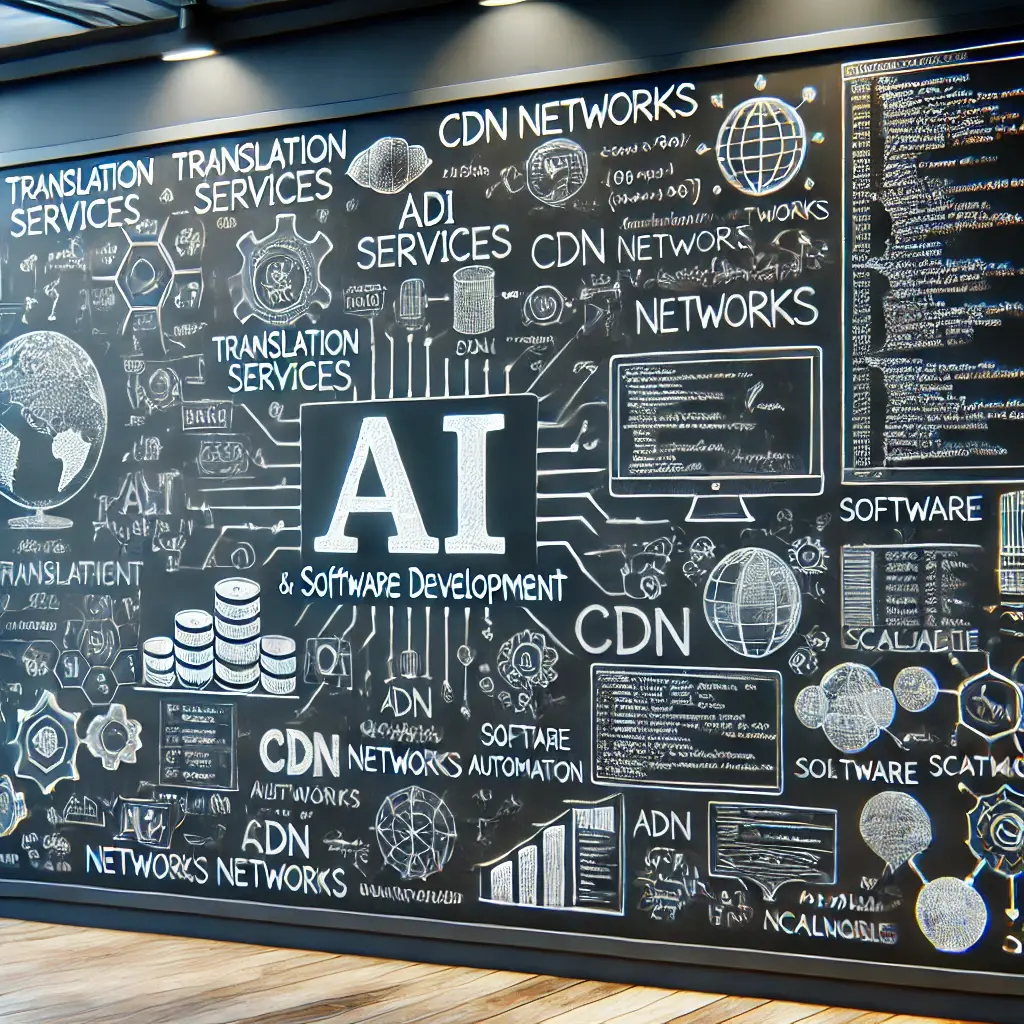Artificial Intelligence (AI) is transforming software development by introducing tools and methodologies that streamline processes, reduce errors, and enhance efficiency. During the “Leveraging AI: Essential Tools for Modern Software Developers” workshop, our experts shared insights on integrating AI-driven tools to address challenges in modern software development. Here’s a discussion summary, including real-world examples and practical advice.
Real-World Use Case: Translation Consistency Across Microservices
The Challenge
One key issue discussed was maintaining consistent translations across multiple microservices. The challenge arose in a system where different frontends (built with React and Vue) relied on separate, inconsistent translation mechanisms. Developers often debated translation choices in merge requests, resulting in inefficiencies and inconsistencies. Additionally, the goal was to make all frontends accessible to international users by ensuring that translations were standardized across services.
Proposed Solutions
Three potential solutions were discussed to address these challenges.
- The first approach involved hard-coding translations directly into service repositories. This method is straightforward but inefficient and unscalable due to the need for frequent updates.
- The second approach proposed using an API-driven translation service, where one could dynamically query translations. However, this posed performance issues, particularly under high traffic, as APIs would be repeatedly accessed.
- The preferred solution was to leverage a Content Delivery Network (CDN) to host translation files. This approach allowed for rapid distribution and ensured consistency across all application frontends. It also offered scalability, better performance, and seamless integration with existing frameworks.
Key Design Considerations
Implementing a CDN-based solution required thoughtful design to ensure effectiveness and scalability. A centralized manager service would maintain translation keys and values, acting as a single source of truth. Builder and deployer modules would generate and deploy translation files to the CDN, ensuring up-to-date application translations.
Our experts emphasized versioning mechanisms to avoid compatibility issues. Applications could reference specific translation file versions that matched their release cycles, ensuring consistency and reducing the risk of errors when updates occurred.
Deep Dive: Implementing a CDN for Translations
How CDNs Solve Translation Challenges
Using a Content Delivery Network (CDN) for translations offers a robust solution to many challenges developers face in maintaining consistency across applications. A CDN provides geographically distributed servers to ensure that translation files are delivered quickly and reliably, regardless of the user’s location. This geographical distribution enhances performance and reduces latency, ensuring users experience minimal delays when loading translations.
Furthermore, CDNs are well-suited for static content, such as translation files, as they can be cached efficiently, making them readily available whenever requested. By aligning translation file versions with application updates, CDNs also support version control, which is critical for maintaining compatibility as applications evolve.
Challenges and Solutions
Despite its advantages, implementing a CDN for translations is not without challenges. One primary issue is managing cache expiration to ensure users receive the latest translations without unnecessary delays. This requires a careful balance between updating cached files promptly and avoiding excessive network overhead.
Another challenge is ensuring backward compatibility, as applications on older versions may still rely on previous translations. To address this, developers can implement semantic versioning for translation files, where each version is linked to a specific application release. This approach ensures that older applications can access the correct translation version while newer ones can seamlessly transition to updated files.
Thoughtful cache management and version control practices are essential to making this approach successful.
Proposed Architecture
The architecture of a CDN-based translation system involves several key components that work together to ensure efficiency and reliability. At the core is a manager service, the centralized repository for all translation keys and values.
This service is responsible for maintaining the integrity of translations and managing updates. Supporting this is a builder, which processs data from the manager service and generates JSON translation files in a format suitable for distribution via the CDN.
A deployer module then uploads these files to the CDN, ensuring the latest translations are available across all geographic regions. Each translation file is versioned and linked to a specific application release to prevent conflicts and ensure compatibility. This modular architecture simplifies the process of managing translations and makes it scalable and adaptable to future growth.
Scaling the Solution
As applications grow and evolve, the volume and complexity of translation data increase, necessitating scalable strategies to maintain performance and reliability. Managing large datasets requires careful planning, such as organizing translations by application and language to streamline access and reduce the size of individual files.
This segmentation allows developers to request only the necessary translations for a specific application or component, improving load times and user experience. Using modular translation files tailored to specific features or functionalities enhances scalability, allowing the system to remain efficient as the dataset grows.
Another critical strategy is implementing semantic versioning, which enables incremental updates to translation files. Developers can reduce disruption and maintain application consistency by making small, manageable changes instead of deploying wholesale updates. These approaches, combined with the capabilities of a CDN, create a robust foundation for handling increasing translation demands.
Alternate Scenarios: Managing Limited Resources
The workshop also addressed scenarios where limited time and resources, common in startups and small teams, can impact decision-making. In such cases, the recommendation was to begin with a monolithic architecture, prioritizing the delivery of a functional product over scalability.
While less flexible than microservices, a monolith architecture is faster to implement and easier to maintain with limited resources. This approach allows teams to focus on meeting immediate deliverables without overextending their capacity. However, scalability should remain a consideration for future growth.
As resources become available, transitioning to a modular or microservice-based architecture can enable more efficient handling of increasing complexity. For long-term planning, maintaining clear documentation and modular design principles in the initial implementation ensures a smoother transition to a scalable system when the time comes. This pragmatic approach balances the need for short-term results with the flexibility to adapt as the project evolves.
Key Learnings and Takeaways
The workshop offered valuable insights into leveraging AI tools and innovative architectures to address complex challenges in modern software development. Here are the primary takeaways:
- Strategic Use of CDNs for Translations
Leveraging Content Delivery Networks (CDNs) can significantly enhance static content distribution, such as translations. Developers can ensure consistency, performance, and compatibility across multiple applications by implementing thoughtful versioning and cache management strategies.
- Scalability Requires Proactive Planning
As applications grow, so do the demands on translation systems. Organizing translation files by language and application, employing modular approaches, and using semantic versioning enables systems to scale efficiently without sacrificing performance.
- Balance Between Immediate Deliverables and Long-Term Goals
In resource-constrained environments like startups, starting with simpler, monolithic architectures allows teams to meet tight deadlines. However, designing with modular principles ensures smoother transitions to scalable solutions when resources become available.
- AI as a Key Enabler
AI tools can optimize workflows, from cache management to streamlining updates, reducing manual intervention and enhancing overall efficiency. Integrating AI solutions into system designs can lead to more reliable and adaptable applications.
- The Value of Collaboration and Feedback
The interactive discussions underscored the importance of peer feedback in refining solutions. Engaging with others helps identify edge cases, challenge assumptions, and enhance the robustness of proposed architectures.
- Future-Proofing Through Modular Design
Modular architectures are essential for handling growing complexities. By isolating components such as translation management, developers can ensure that their systems are adaptable and maintainable as demands evolve.
Q&A and Peer Feedback
The workshop’s interactive segment allowed participants to share their thoughts and receive constructive feedback on the proposed solutions. The discussions centered around the practicalities of implementing a CDN-based translation system, with particular emphasis on synchronization across geographically distributed CDN servers.
Attendees also explored strategies for managing cache expiration and versioning, ensuring backward compatibility for applications on older versions. They highlighted the importance of AI-driven tools to optimize cache management and streamline updates and the necessity of planning for scalability from the outset.
Constructive peer feedback encouraged participants to refine their solutions by considering edge cases, such as handling large datasets or ensuring seamless updates for diverse user bases. This collaborative exchange of ideas emphasized the importance of iterative development and adaptability in addressing real-world challenges.
Conclusion
The workshop highlighted the transformative power of AI tools in solving complex software development challenges. Developers can build robust, scalable systems by leveraging CDNs for translations, adopting modular architectures, and balancing short-term and long-term goals.
Whether tackling translation inconsistencies or managing resources in a startup, the lessons shared demonstrate the importance of aligning AI-driven solutions with specific needs. The future of software development lies in thoughtfully integrating these tools, ensuring efficiency and adaptability in a rapidly evolving industry.


